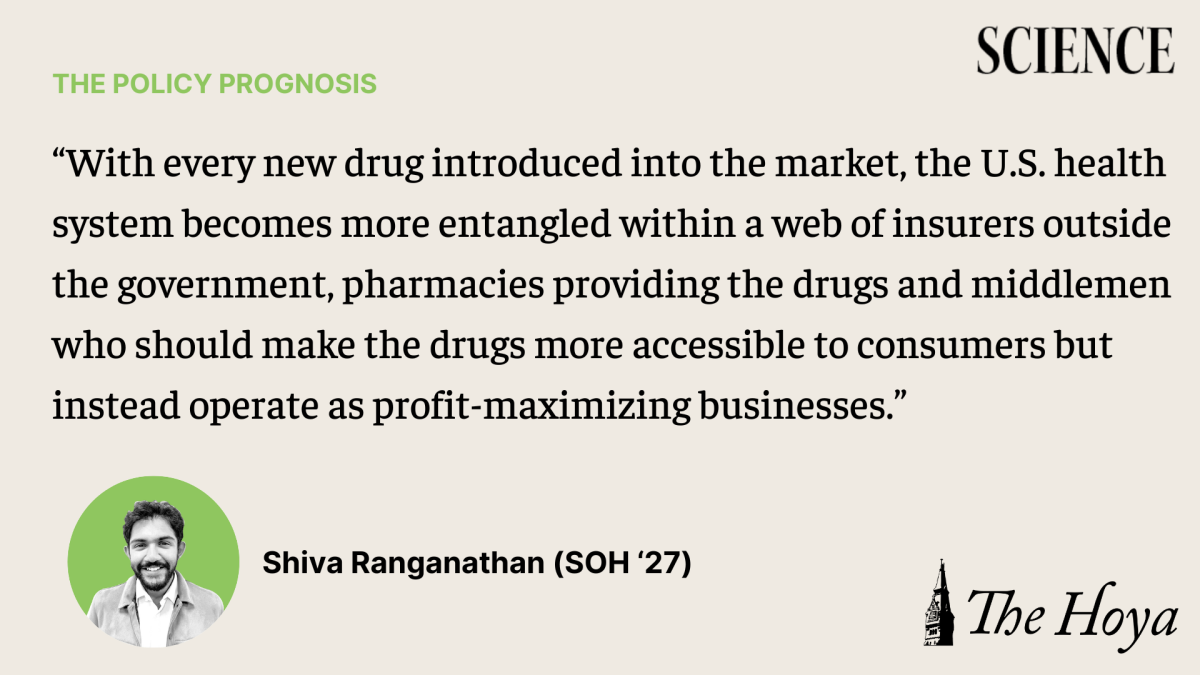The case of pharmacy benefit managers’ (PBMs) exploitation is a testament to the faults of the U.S. private insurance system, which leaves footholds for insurers, drug manufacturers and PBMs to profit from consumer blindness.
In the United States, where private insurance dominates, the list of prescription drugs covered by a particular insurance plan, known as the company’s drug formulary, drastically changes drug affordability for the average consumer. Formularies rank drugs in a tiered system, placing the drugs with the costliest customer co-payments on the highest tier. These high-tier drugs tend to be inaccessible, while other drugs are sometimes not present in the formulary to begin with. To get its drugs higher on a formulary — and therefore, to yield more profit from its sales — pharmaceutical companies make payments to insurance firms called rebates.
This negotiation is where PBMs step in. Theoretically, their role is to lower the cost of drugs for insurance companies — and the patients they insure — by settling rebate costs. This role assumes that the PBMs act as an unbiased third party, separate from insurers and drug producers. Currently, six PBMs process 95% of private prescription claims.
The design should help consumers save money by allowing PBMs to prevent companies from overcharging for their drugs on insurance formularies. However, the price that PBMs pay to buy drugs from manufacturers seldom matches the price insurance companies pay to stock the drugs on shelves.
For example, CVS Caremark, the PBM branch of the pharmacy company CVS Health Corporation, charged Ohio’s Medicaid insurance 8.8% more to buy pharmaceuticals than they reimbursed pharmacies for drugs they sold to the insurance company, pocketing the difference.
Furthermore, PBMs aren’t the only ones taking advantage of consumer unawareness. Larger pharmaceutical companies can pay higher rebate prices to keep their more expensive drugs at the highest tier on insurance formularies, so doctors are forced to prescribe whatever drug their hospital insurance favors rather than affordable generic alternatives.
Since consumers typically only have access to prescriptions that doctors order, and doctors must overlook drug prices to follow insurance formularies, consumers have no control over the price of a drug they need if it is a high enough tier.
Health systems that control both the insurance and PBM sides of their health administration can underpay pharmaceutical companies without consequences. Moreover, they tend to operate ineffectively due to internal competition, having both their PBMs and insurance trying to profit against each other. This dynamic undermines value-based care, or the prioritization of patient outcomes over making a profit.
However, PBMs aren’t entirely to blame for high drug prices.
Patent repetition is largely responsible for the inconsistent affordability of certain drugs. To incentivize drug development, the Food and Drug Administration gives patents to first-in-class drugs to eliminate competition for as long as the patent is valid. Patents prevent biosimilars, or generic drugs with slight chemical differences, from being sold on the market, allowing the original drug creator to create a monopoly.
After the patent time period is over, similar drugs enter the market, and the increased supply of drugs paired with competition drives prices down for consumers. However, drug manufacturers sometimes create drugs that are almost identical to existing products and get new patents for them, which gouges money from consumers without any innovation.
Therefore, to adequately address high drug costs, policymakers must hold all stakeholders accountable. PBMs play just as important a role in raising drug prices as insurance companies and drug manufacturers do.
The federal government has proposed some new policies to restrict PBMs, such as the Pharmacy Benefit Manager Transparency Act of 2023. The bill would require PBMs to have more transparency about their budgeting between pharmaceutical companies and insurance providers. However, the bill has only passed in the Senate, so more legislative support is required to codify the legislation as law.
Additionally, PBMs can still take advantage of many loopholes in our healthcare system. For example, Express Scripts, an online PBM owned by private insurance company Cigna Healthcare, was recently sued for colluding with competing PBMs to collectively set higher rebate prices for pharmacies so the PBMs could take the increased chunk of money.
With every new drug introduced into the market, the U.S. health system becomes more entangled within a web of insurers outside the government, pharmacies providing the drugs and middlemen who should make the drugs more accessible to consumers but instead operate as profit-maximizing businesses.










Bill Nulman • Mar 2, 2024 at 6:07 am
Excellent article that encapsulates the current state. As a 27-year pharmacy benefit consultant, I have seen first-hand the devastation that PBMs cause, feigned by industry buzz words such as “lowest net-cost”, “we do not chase rebates”, and the most ambiguous word, “transparency”.
In addition to what you have captured, every PBM in the country includes illegal non-FDA-approved medications on their formularies, which is against Federal Law, and charges their clients egregiously for these illegal medications that have never been reviewed by the FDA for safety, clinical effectiveness, nor side effects.
Contact me if you want to learn more about this significant and pervasive issue about which most plan sponsors and patients do not know, as the PBMs do not want for them to know. Thank you.